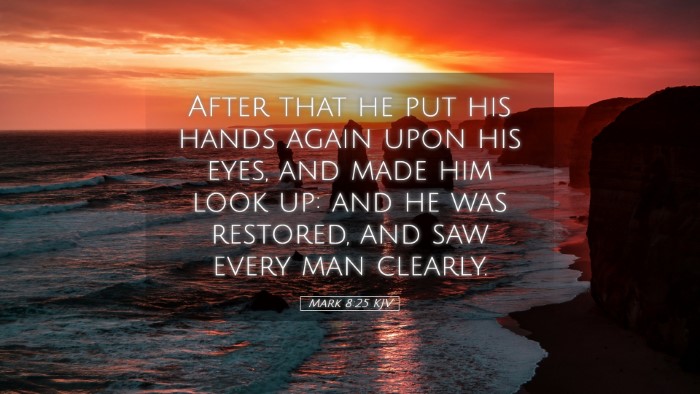Bible Commentary on Mark 8:25
Verse Overview: Mark 8:25 states, "Then he laid his hands on his eyes again; and made him look up: and he was restored, and saw every man clearly." This verse captures a significant moment in the ministry of Jesus, showcasing the healing of a blind man in Bethsaida.
Context and Significance
This miracle follows the feeding of the four thousand and predates Peter’s confession about the identity of Jesus. In Mark’s gospel, this miracle represents not only a physical healing but also a deeper spiritual message about sight and understanding.
Miracle of Restoration
Matthew Henry comments on the two-stage healing process, noting that it illustrates both a physical and spiritual insight. It allows the observer to consider the gradual opening of the senses, symbolizing the stages of faith that every believer may encounter.
Albert Barnes points out that the blind man represents humanity’s spiritual blindness. The act of Jesus laying hands on him again signifies the need for Jesus’ continual work in the lives of believers, as faith may need to be nurtured through successive encounters with Jesus.
Interpretative Insights
- Two-Part Healing: The first touch left the man seeing men as trees walking, indicating an incomplete sight, which highlights the progressive nature of God's revelation and healing in our lives.
- Spiritual Blindness: The healing can be viewed as an allegory for spiritual enlightenment; initially, we may see things imperfectly, but we are called to seek clarity through Christ.
- Restoration: Clarke draws attention to the completeness of the final sight, emphasizing that true spiritual insight comes from a relationship with Christ, which is necessary for a clear perception of God’s truth.
Theological Reflections
User insights from these commentaries provide a richer theological framework:
Human Condition and Divine Intervention
The blind man's experience reflects mankind’s inherent need for divine intervention. As Adam Clarke notes, our initial understanding of truth can be clouded like the blind man’s—seeing indistinctly until we encounter the touch of Jesus which brings full clarity and understanding.
Progressive Revelation
This miracle illustrates the concept of progressive revelation. According to Barnes, it depicts the believer's journey toward understanding God's nature and will. Just as the man did not see clearly after the first touch, believers may often misinterpret God's workings in their lives until they receive fuller revelation through prayer and Scripture.
Application for Believers
This passage challenges Christians to reflect on their own spiritual sight. How often do we view spiritual truths as indistinct or unclear? Are there areas of our lives that need a second touch from God? Here are some practical applications:
- Seek Clarity: Approach God with the expectation that He can clarify areas of confusion in our spiritual walk.
- Recognize the Process: Understand that spiritual growth often takes place in stages. It is acceptable to seek understanding progressively.
- Community and Ministry: Encourage others in their journey. Just as the blind man was brought to Jesus, we have a responsibility to guide others toward divine healing and understanding.
Concluding Thoughts
Mark 8:25 is a profound reminder of Jesus’ ability to restore sight—not just physically, but spiritually. The collaboration of insights from Matthew Henry, Albert Barnes, and Adam Clarke reveals a multidimensional understanding of this passage that can inspire and equip pastors, students, and scholars alike.
Let this miracle compel believers to recognize their need for ongoing revelation and healing in their spiritual lives, deepening their desire for a clearer vision of Christ and His purposes.


